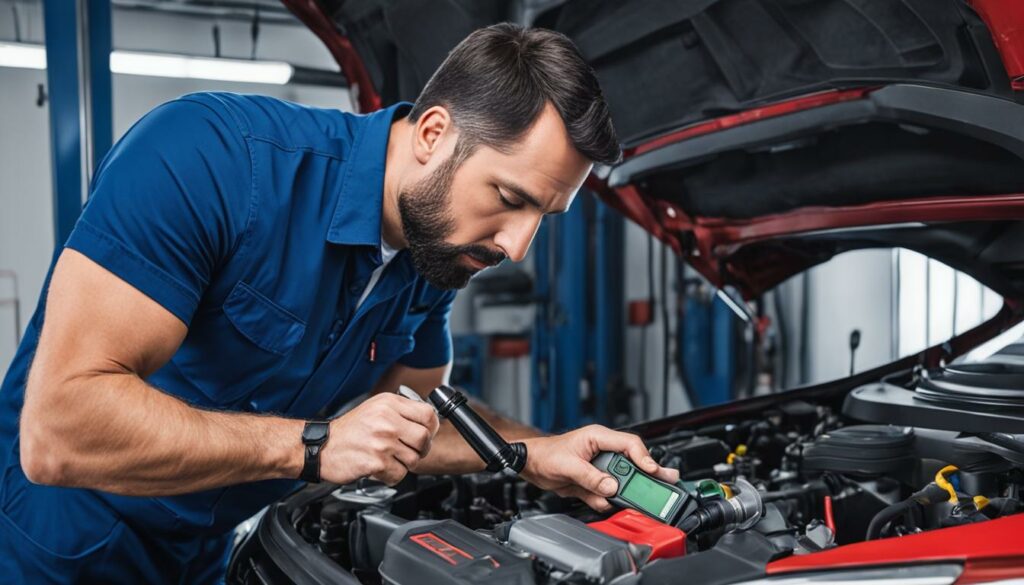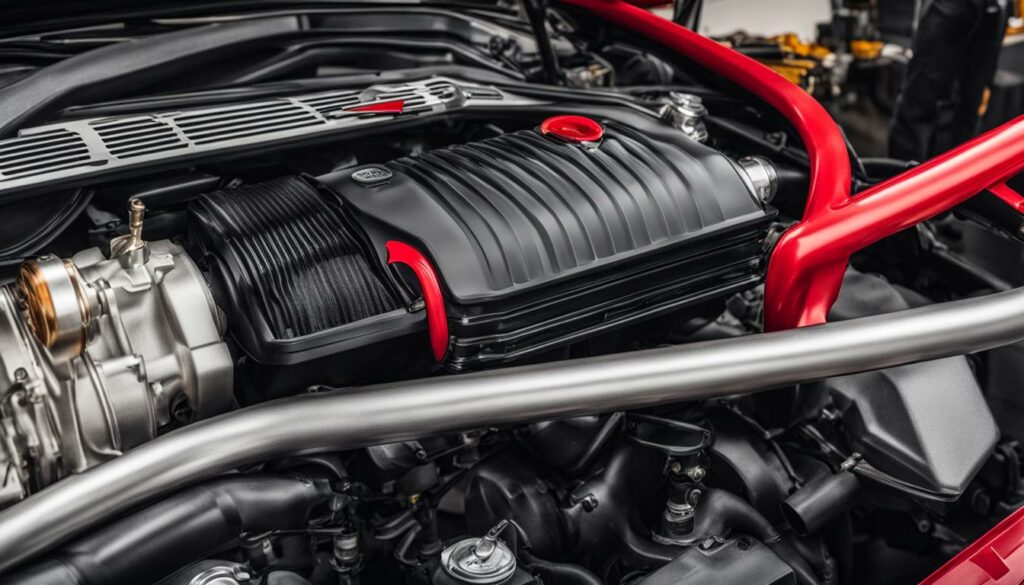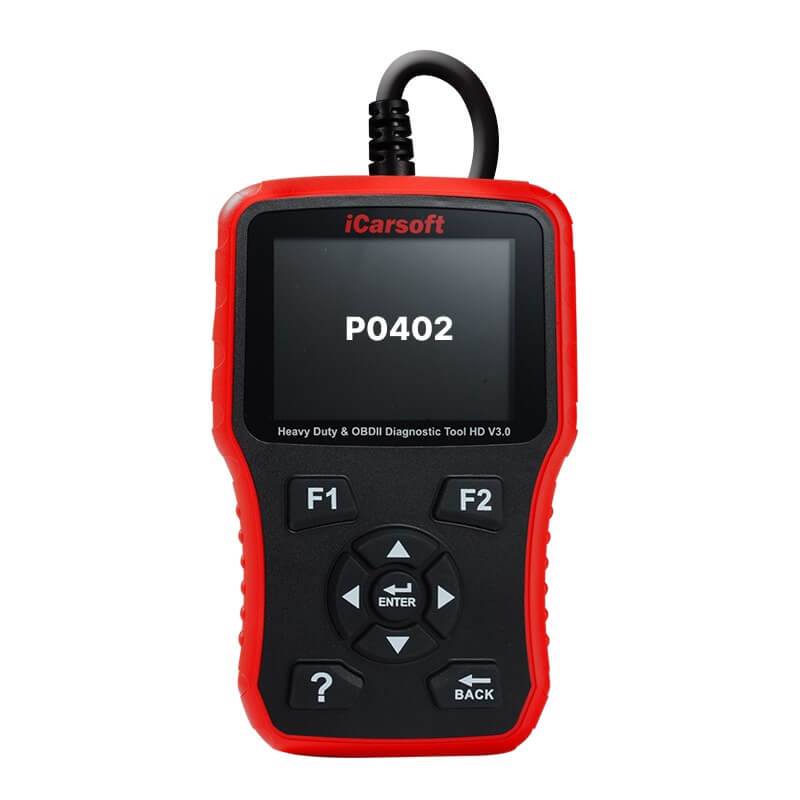P0402 – Exhaust Gas Recirculation Flow Excessive Detected
POSTED IN pcodes
Welcome to our comprehensive guide on the P0402 code – Exhaust Gas Recirculation (EGR) Flow Excessive Detected. If you’ve encountered this code, your vehicle’s engine control module (ECM) has detected an abnormal amount of exhaust gas recirculation. This issue can cause various symptoms and requires proper troubleshooting to identify the root cause and perform the necessary repairs.
Excessive EGR flow can occur due to a malfunctioning EGR valve, blockage in the EGR system, or other related issues. By understanding the causes and symptoms of the P0402 code, you’ll be better equipped to resolve this problem and restore your vehicle’s performance. In this article, we’ll guide you through the diagnostic process and highlight common mistakes to avoid. We’ll also discuss the severity of the code, available repairs, and professional assistance options.
Continue reading to learn how to troubleshoot and fix the P0402 code, ensuring your vehicle runs smoothly and efficiently.
Key Takeaways:
- The P0402 code indicates excessive exhaust gas recirculation (EGR) flow.
- Possible causes include a malfunctioning EGR valve, blockage in the EGR system, or excessive back pressure.
- Symptoms may include a rough running engine, Check Engine Light illumination, or emission test failure.
- Proper diagnosis involves scanning for codes, visual inspections, and testing EGR system components.
- Repairs may include replacing the EGR valve, repairing the exhaust catalyst, or cleaning carbon deposits. Professional assistance or alternative solutions may be necessary in certain cases.
Symptoms of P0402 Code
If you’re dealing with the P0402 code, there are a few common symptoms to watch out for. The most obvious sign is the illumination of the Check Engine Light on your vehicle’s dashboard. This warning light serves as an early indicator that something is amiss with the engine’s exhaust gas recirculation (EGR) system.
Another symptom that may arise if the EGR valve is stuck open is rough running of the engine. You may notice that your engine is not running as smoothly as it used to, with a noticeable decrease in performance and increased vibrations. This can be a result of the excessive flow of exhaust gas through the EGR system.
Buy tested tuning file for Adblue / EGR / DPF / Adblue off now!
In some cases, there may also be exhaust leaks in the EGR system, particularly around the back pressure transducer. These leaks can further exacerbate the issue and lead to additional complications if left unaddressed.
It’s important to address these symptoms promptly to prevent further damage to your engine and to ensure that your vehicle remains compliant with emission testing requirements. Ignoring these signs can lead to more severe issues down the line, potentially resulting in costly repairs.
“The most obvious sign is the illumination of the Check Engine Light on your vehicle’s dashboard.”
Dealing with the symptoms of the P0402 code can be quite troublesome, but it’s crucial to take action and have the issue resolved. In the next section, we will explore the steps to diagnose the P0402 code and identify the underlying cause.
| Symptoms of P0402 Code |
|---|
| Illumination of the Check Engine Light |
| Rough running of the engine |
| Exhaust leaks in the EGR system |
Diagnosing the P0402 Code
When dealing with the P0402 code, it is crucial to properly diagnose the issue to pinpoint the exact cause. This will enable you to perform the necessary repairs effectively. Here are the diagnostic steps to follow:
- Scan for codes: Start by using an OBD-II scanner to retrieve the trouble codes from the vehicle’s ECM. Look specifically for the P0402 code related to excessive exhaust gas recirculation (EGR) flow.
- Document freeze frame data: Take note of any freeze frame data recorded by the ECM when the code was triggered. This information can provide valuable insights into the conditions under which the code occurred.
- Clear codes and road test: Clear the codes from the ECM and take the vehicle for a road test. Monitor the system to see if the P0402 code reappears. If it does, you know there is still an issue that needs to be addressed.
- Perform visual inspection: Inspect the vacuum hoses, wiring, and connections related to the EGR valve, control solenoid, EGR temperature sensor, and back pressure transducer. Look for any signs of damage, leaks, or loose connections that could contribute to the excessive EGR flow.
- Check EGR valve vacuum control: Verify if the EGR valve vacuum can be controlled when the control solenoid opens. This test ensures that the EGR valve is functioning correctly.
- Inspect the exhaust catalyst: Examine the EGR system’s exhaust catalyst for any signs of damage or excessive back pressure. This can restrict the flow of exhaust gases and lead to the P0402 code.
- Remove the EGR valve and temperature sensor: Take out the EGR valve and temperature sensor for a closer inspection. Look for carbon buildup or blockage that may be hindering their proper functioning.
Following these diagnostic steps will help you identify the root cause of the P0402 code and enable you to perform the necessary repairs with confidence.
Common Mistakes when Diagnosing the P0402 Code
When diagnosing the P0402 code, it is important to avoid common mistakes that could lead to inaccurate diagnoses and unnecessary repairs. By understanding these common pitfalls, you can ensure that the root cause of the excessive EGR flow is properly addressed.
1. Replacing the EGR Valve without Checking the EGR Pressure Transducer
One common mistake is replacing the EGR valve without checking the EGR pressure transducer. The EGR pressure transducer plays a crucial role in monitoring the pressure within the EGR system and ensuring proper EGR valve operation. Failing to check and diagnose this component can result in replacing the EGR valve unnecessarily.
2. Failing to Check if the EGR Valve is Mechanically Held Open by Carbon Deposits
Another mistake is failing to check if the EGR valve is mechanically held open by carbon deposits. Over time, carbon buildup can cause the EGR valve to stick in the open position, leading to excessive EGR flow. By inspecting the EGR valve for carbon deposits and cleaning or replacing it if necessary, you can eliminate this potential cause.
By avoiding these common mistakes, you can accurately diagnose the P0402 code and ensure that the appropriate repairs are made. Taking the time to properly diagnose the issue will save you time and money in the long run, as well as ensure the optimal performance and longevity of your vehicle.

This guide will help you diagnose the P0402 code accurately:
1. Scan for Codes and Document Freeze Frame Data: Use an OBD-II scanner to retrieve the P0402 code and document any freeze frame data associated with the code. This information can help you understand the conditions under which the code was triggered.
2. Clear Codes and Road Test: Clear the codes and take your vehicle for a road test to determine if the P0402 code returns. This step will help you verify if the code is an intermittent issue or a persistent problem.
3. Visual Inspection: Perform a visual inspection of the vacuum hoses, wiring, connections to the EGR valve, control solenoid, EGR temperature sensor, and back pressure transducer. Look for any signs of damage or disconnection that could be causing the excessive EGR flow.
4. EGR Valve Vacuum Control: Check if the EGR valve vacuum can be controlled when the control solenoid opens. This test will help you determine if the vacuum system is functioning properly and if the EGR valve is responding as it should.
Tip: Use a hand vacuum pump to manually apply vacuum to the EGR valve and observe its response. If the valve opens and closes smoothly, the mechanical operation is likely normal.
5. Back Pressure Test: Check for any damage or excessive back pressure on the EGR system’s exhaust catalyst. Excessive back pressure can contribute to the P0402 code and should be addressed accordingly.
6. EGR Valve and Temperature Sensor Inspection: Remove the EGR valve and temperature sensor to inspect for carbon buildup or blockage. Clean or replace these components as necessary to ensure proper EGR flow.
By following these diagnostic steps and avoiding common mistakes, you can accurately diagnose and resolve the P0402 code, ensuring the optimal performance of your vehicle.
Severity of the P0402 Code
The severity of the P0402 code can vary depending on the specific symptoms experienced. An EGR valve with excessive flow can cause hesitation or stalling on acceleration and rough engine idle. The Check Engine Light resulting from the code can also cause the vehicle to fail emission testing. In some cases, if the catalyst is blocked, it could lead to engine power loss or the vehicle not starting. Prompt diagnosis and repair of the code are important to prevent further damage and ensure proper vehicle operation.
| Severity Level | Description |
|---|---|
| Mild | The vehicle may experience slight hesitation or rough idle. Check Engine Light illuminates, but the vehicle can still be driven without significant issues. |
| Moderate | Acceleration may become difficult, causing the vehicle to hesitate or stall. The Check Engine Light remains illuminated, and the vehicle may exhibit rough running at idle. |
| Severe | The Check Engine Light stays on and the vehicle experiences consistent hesitation or stalling during acceleration. Rough idle becomes more pronounced, potentially leading to engine power loss or the vehicle not starting. |
It is important to address the severity of the P0402 code promptly to prevent further damage to the engine and ensure the vehicle passes emission testing. By taking immediate action, you can protect your engine and maintain optimal performance.
Repairs for the P0402 Code
When faced with the P0402 code, there are several possible repairs that can be undertaken to resolve the issue. These fixes target the specific causes of the excessive EGR flow, ensuring that the code is rectified and the vehicle operates optimally. The following repair options should be considered:
- Replace the Stuck Open EGR Valve: If the EGR valve is stuck open, it should be replaced to restore proper functioning. This will prevent an excessive flow of exhaust gas recirculation and resolve the P0402 code.
- Repair or Replace a Broken Catalyst in the Exhaust: In some cases, a broken catalyst in the exhaust can cause excessive EGR flow. If this is identified as the culprit, repairing or replacing the catalyst will address the issue and eliminate the P0402 code.
- Replace the EGR Temperature Sensor: A faulty EGR temperature sensor can also contribute to the P0402 code. By replacing the sensor, accurate temperature readings can be obtained, allowing for proper EGR flow control.
- Clean Carbon Buildup from the EGR Valve or EGR Bleed Port: Carbon deposits can accumulate on the EGR valve or EGR bleed port over time, hindering their functionality. Cleaning these components will help restore normal EGR flow and resolve the P0402 code.
It is crucial to diagnose the specific cause of the excessive EGR flow before proceeding with any repairs. This will ensure that the appropriate fix is implemented and the P0402 code is effectively addressed. Consulting a professional mechanic or referring to the vehicle’s repair manual can provide valuable guidance during the repair process.
Fixing the P0402 code requires targeted repairs to address the underlying causes of the excessive EGR flow. By replacing the stuck open EGR valve, repairing or replacing a broken catalyst, replacing the EGR temperature sensor, or cleaning carbon buildup from the EGR valve or EGR bleed port, you can successfully resolve the P0402 code and optimize your vehicle’s performance.

Professional Assistance for the P0402 Code
If professional assistance is unavailable, there is an alternative solution for dealing with the P0402 code. You can opt for the permanent removal of the specific Pcode by uploading the Engine Control Unit (ECU) file to a portal that specializes in ECU tuning. This option should be considered when all other repair attempts have been exhausted, and the code continues to persist.
ECU tuning involves modifying the software parameters of the engine control unit to optimize performance and eliminate any undesired error codes. By reprogramming the ECU, you can effectively remove the P0402 code and its associated issues.
Take Expert Help: ECU tuning is a specialized process that requires technical expertise and knowledge. It is always recommended to consult with professionals who are well-versed in ECU tuning for the best results.
When dealing with complex automotive issues like the P0402 code, seeking professional assistance ensures accurate diagnosis and effective solutions. However, if such assistance is not readily accessible, ECU tuning can serve as a viable alternative to address the persistent P0402 code and restore your vehicle’s performance.
Conclusion
The P0402 code, which indicates an excessive flow of exhaust gas recirculation (EGR), can be a result of various factors such as a stuck open EGR valve, blocked vacuum diaphragm, or excessive back pressure in the EGR system. Prompt diagnosis and repair of this code are crucial to prevent further damage to your vehicle’s engine and ensure optimal performance.
To address the P0402 code, it is highly recommended that you consult with a professional mechanic who can accurately diagnose the specific cause of the excessive EGR flow. An expert will be able to perform the necessary repairs and resolve the issue effectively. They will inspect the vacuum hoses, wiring, connections, control solenoid, EGR temperature sensor, and back pressure transducer to identify the root cause of the problem.
In situations where professional assistance is unavailable, exploring alternative solutions like ECU tuning can be considered. This involves uploading the Engine Control Unit (ECU) file to a specialized portal that can remove the P0402 code permanently. However, it is crucial to exhaust all possible repair options before resorting to this alternative.
In conclusion, the P0402 code must be addressed promptly and accurately to prevent further engine damage and ensure smooth vehicle operation. Seek the expertise of a professional mechanic or explore alternative solutions like ECU tuning when professional assistance is unavailable. Taking appropriate action will help keep your vehicle running efficiently and prolong its lifespan.
FAQ
What does the P0402 code mean?
The P0402 code indicates that the engine control module has detected an excessive flow of exhaust gas recirculation (EGR).
What are the symptoms of the P0402 code?
The symptoms of the P0402 code include the illumination of the Check Engine Light and rough running of the engine if the EGR valve is stuck open. Additionally, there may be exhaust leaks in the EGR system at the back pressure transducer.
How is the P0402 code diagnosed?
The diagnosis of the P0402 code involves scanning for codes and documenting freeze frame data. Visual inspection of the vacuum hoses, wiring, connections to the EGR valve, and back pressure transducer should also be performed.
What are common mistakes when diagnosing the P0402 code?
Common mistakes when diagnosing the P0402 code include replacing the EGR valve without checking the EGR pressure transducer and failing to check if the EGR valve is mechanically held open by carbon deposits.
How severe is the P0402 code?
The severity of the P0402 code can vary depending on the specific symptoms experienced. It can cause hesitation or stalling on acceleration, rough engine idle, and may lead to engine power loss or the vehicle not starting.
What are the repairs for the P0402 code?
The repairs for the P0402 code may involve replacing the stuck open EGR valve, repairing or replacing a broken catalyst in the exhaust, replacing an EGR temperature sensor, or cleaning carbon buildup from the EGR valve or EGR bleed port.
Is professional assistance necessary for the P0402 code?
It is recommended to consult with a professional mechanic when diagnosing and repairing the P0402 code. They have the expertise and tools to accurately diagnose and fix the underlying issue.
What should I do if professional assistance is unavailable?
If professional assistance is unavailable, an alternative solution for the P0402 code is the permanent removal of the specific code through ECU tuning. This should only be considered after exploring all other repair options.


